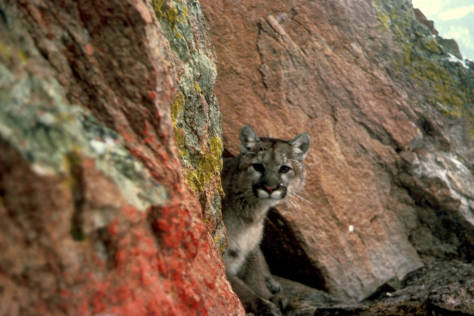
Courtesy US FWS Digital Library
Deep in the forest shadows materialized a form- a coyote! Well, that was the initial thinking. I stopped for closer inspection and began talking in a soft, welcoming tone so as not to frighten away my favorite song dog.
The animal form persisted- no frenzied running up the steep slope just beyond. Interesting.
I walked toward the figure to find the fright distance and for closer encounter. Eight steps in crunchy leaves and the animal began to move. Wow! A long tail emerges. The canine face transforms to feline. MOUNTAIN LION!!!
After 50+ years of trapesing through wild, rugged country in the western U.S., dream becomes reality- that of seeing this shadow being in real form.
Mesmerized, I continue a cautious approach. The cat holds its ground. Our distance closes to 50 yards when it begins a leisurely retreat. I continue singing praises to its magnificence. At one point I find myself emitting “Here Kitty, Kitty, Kitty” to which fortunately it doesn’t respond.

Courtesy USDA Forest Service
Eventually it gains the steep slope and picks its way upward. Occasional sunburst accents the rich tawny gold and well-muscled body. Eyes strain to follow its progress, fading into the dream it once was.
Cougars are solitary animals, making them a rare sight for humans. They usually hunt alone and at night, ambushing their prey from behind. Typically, cougars kill their prey with a bite to the lower neck. After making a kill, a cougar often will take the carcass to the base of a tree and cover it with dirt, leaves or snow, saving it to eat later.
Their main prey is deer, so cougars are often found close by. They can live up to 12 years in the wild but have lived up to 25 years in captivity.
Only 20 people in North America have been killed by cougars during the past 125 years, including six in California and 8 in Canada. No deaths have ever been reported in Utah. It is far less likely than dying from snake bites, avalanches, lightning strikes, hypothermia, or bee stings, or just about any other means. Children are particularly vulnerable when alone.
If approached by one, intimidation by intense eye contact, loud shouting, and any other actions to appear larger and more menacing is warranted.
This is Jack Greene writing and reading for Wild About Utah.
Credits:
Images: Courtesy US FWS Digital Library
Text: Jack Greene
Sources & Additional Reading:
Mountain Lion, Wildlife Notebook, Utah Division of Wildlife Resources,
https://wildlife.utah.gov/publications/pdf/newlion.pdf
Starving Cougar Attacks Vernal Man, Hans Moran, Deseret News Nov. 12, 1997, https://www.deseretnews.com/article/594408/Starving-cougar-attacks-Vernal-man.html
Mountain Lion, National Geographic, https://animals.nationalgeographic.com/animals/mammals/mountain-lion.html
